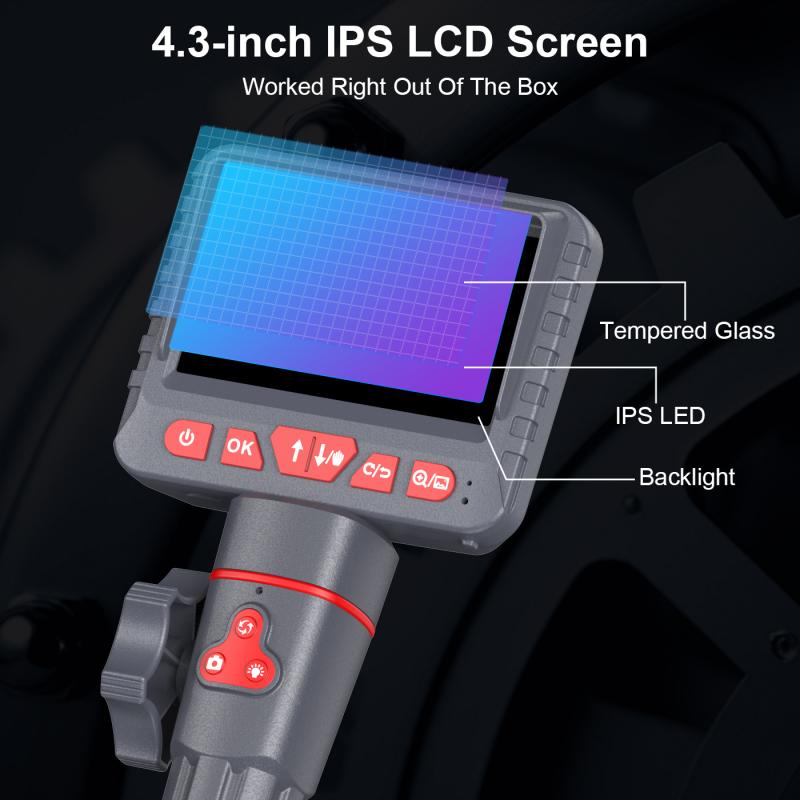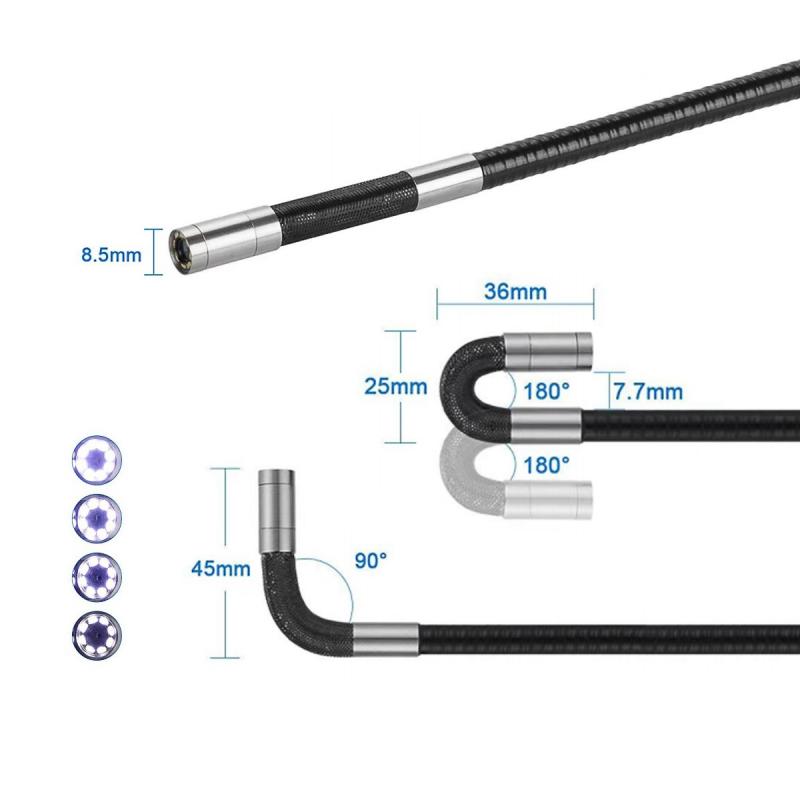Can A Biopsy During Endoscope Detect Anemia ?
A biopsy during an endoscope procedure cannot directly detect anemia. Anemia is a condition characterized by a low level of red blood cells or hemoglobin in the blood. It is typically diagnosed through blood tests that measure the levels of these components. A biopsy, on the other hand, involves the removal of a small sample of tissue for further examination under a microscope. It is commonly used to diagnose various conditions, such as cancer or inflammation, but not anemia.
1、 Endoscopic biopsy: Limited ability to detect anemia directly.
Endoscopic biopsy: Limited ability to detect anemia directly.
An endoscopic biopsy is a procedure in which a small tissue sample is taken from the body using an endoscope, a flexible tube with a camera and a light at the end. This procedure is commonly used to diagnose various conditions, including cancer, inflammation, and infection. However, when it comes to detecting anemia, the ability of an endoscopic biopsy is limited.
Anemia is a condition characterized by a decrease in the number of red blood cells or a decrease in the amount of hemoglobin in the blood. It can be caused by various factors, such as iron deficiency, vitamin B12 deficiency, or chronic diseases. To diagnose anemia, blood tests are typically used to measure the levels of red blood cells, hemoglobin, and other related parameters.
While an endoscopic biopsy can provide valuable information about the underlying cause of anemia, it does not directly measure the levels of red blood cells or hemoglobin. The biopsy sample is usually examined under a microscope to identify any abnormalities or signs of disease. This can help in determining the cause of anemia, such as gastrointestinal bleeding or inflammation, which may require further investigation or treatment.
However, it is important to note that recent advancements in technology have led to the development of new techniques that may enhance the ability of endoscopic biopsies to detect anemia indirectly. For example, some studies have explored the use of advanced imaging techniques, such as narrow-band imaging or confocal laser endomicroscopy, to assess the microvasculature and mucosal changes associated with anemia. These techniques may provide additional information about the severity or progression of anemia.
In conclusion, while an endoscopic biopsy can provide valuable insights into the underlying cause of anemia, its direct ability to detect anemia is limited. Blood tests remain the primary method for diagnosing anemia and assessing its severity. However, advancements in imaging techniques may offer new possibilities for indirectly evaluating anemia during an endoscopic biopsy. It is important for healthcare professionals to consider a comprehensive approach, combining clinical evaluation, blood tests, and endoscopic findings, to accurately diagnose and manage anemia.

2、 Endoscopic evaluation: May reveal signs of anemia-related conditions.
Endoscopic evaluation: May reveal signs of anemia-related conditions.
During an endoscopic procedure, a biopsy can be performed to obtain tissue samples for further examination. While the primary purpose of an endoscopy is to visualize the gastrointestinal tract and diagnose various conditions, it can also provide valuable information about anemia-related conditions.
Anemia is a condition characterized by a decrease in the number of red blood cells or a decrease in the amount of hemoglobin in the blood. It can be caused by various factors, including nutritional deficiencies, chronic diseases, and gastrointestinal bleeding. Endoscopy can help identify the underlying cause of anemia by detecting signs of bleeding or other abnormalities in the gastrointestinal tract.
During an endoscopy, the physician can visually inspect the lining of the esophagus, stomach, and small intestine. They can identify signs of inflammation, ulcers, tumors, or other abnormalities that may be contributing to anemia. Additionally, the endoscope can be used to perform biopsies, where small tissue samples are collected for further analysis.
These biopsies can provide valuable information about the presence of conditions such as gastritis, peptic ulcers, celiac disease, or gastrointestinal tumors, which can all contribute to anemia. By examining the tissue samples under a microscope, pathologists can identify any abnormalities or signs of inflammation that may be causing or contributing to the anemia.
It is important to note that while endoscopic evaluation can provide valuable information about anemia-related conditions, it is not the only diagnostic tool available. Blood tests, including a complete blood count (CBC) and iron studies, are also commonly used to diagnose and monitor anemia. Additionally, other imaging techniques such as CT scans or MRI may be necessary to evaluate the extent of any identified abnormalities.
In conclusion, while an endoscopic biopsy can provide valuable information about anemia-related conditions, it is just one piece of the diagnostic puzzle. A comprehensive evaluation, including blood tests and other imaging techniques, is often necessary to accurately diagnose and manage anemia.

3、 Histopathological analysis: Can identify anemia-related changes in tissue samples.
Histopathological analysis during an endoscopic biopsy can indeed help identify anemia-related changes in tissue samples. Anemia is a condition characterized by a decrease in the number of red blood cells or a decrease in the amount of hemoglobin in the blood. It can be caused by various factors, including nutritional deficiencies, chronic diseases, or blood disorders.
During an endoscopic biopsy, a small sample of tissue is collected from the affected area using an endoscope, which is a flexible tube with a camera and a light source. This tissue sample is then sent to a laboratory for histopathological analysis. Histopathology involves the examination of tissue samples under a microscope to study the structural and cellular changes that may be indicative of a particular disease or condition.
In the case of anemia, histopathological analysis can reveal important information about the tissue changes associated with this condition. For example, in cases of iron-deficiency anemia, the histopathological examination may show changes in the bone marrow, such as decreased iron stores or abnormal red blood cell production. Similarly, in cases of anemia caused by chronic diseases, the analysis may reveal inflammation or other specific changes in the affected tissues.
It is important to note that histopathological analysis alone may not be sufficient to diagnose anemia or determine its underlying cause. A comprehensive evaluation, including a thorough medical history, physical examination, and laboratory tests, is usually necessary. However, histopathological analysis can provide valuable insights into the tissue changes associated with anemia and help guide further diagnostic and treatment decisions.
It is worth mentioning that medical knowledge and research are constantly evolving. Therefore, the latest point of view may include advancements in histopathological techniques or the discovery of new markers that can aid in the identification of anemia-related changes in tissue samples. Researchers are continually working to improve diagnostic methods and enhance our understanding of anemia and its underlying mechanisms.

4、 Iron deficiency anemia: Endoscopic findings may suggest underlying causes.
A biopsy during an endoscope procedure can help detect various conditions, including anemia. However, it is important to note that a biopsy alone may not directly detect anemia itself. Anemia is a condition characterized by a decrease in the number of red blood cells or a decrease in the amount of hemoglobin in the blood. To diagnose anemia, blood tests are typically performed to measure the levels of red blood cells, hemoglobin, and other related parameters.
During an endoscope procedure, a biopsy can be taken to examine the tissue for any abnormalities or underlying causes of anemia. For example, if a person is suspected to have iron deficiency anemia, the endoscopic findings may suggest potential sources of bleeding or gastrointestinal disorders that could be causing the iron deficiency. These findings can guide further investigations and help determine the appropriate treatment plan.
It is worth mentioning that the latest point of view regarding the diagnosis of anemia involves a comprehensive approach. In addition to endoscopic findings, other diagnostic tools such as blood tests, imaging studies, and clinical evaluation are essential to accurately diagnose and manage anemia. The combination of these approaches allows healthcare professionals to identify the underlying cause of anemia and provide appropriate treatment, which may include iron supplementation, dietary changes, or addressing any other contributing factors.
In summary, while a biopsy during an endoscope procedure can provide valuable information about potential underlying causes of anemia, it is not a direct method for detecting anemia itself. A comprehensive diagnostic approach, including blood tests and clinical evaluation, is necessary to accurately diagnose and manage anemia.






































